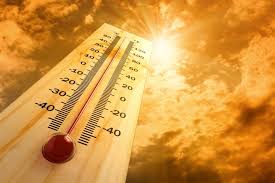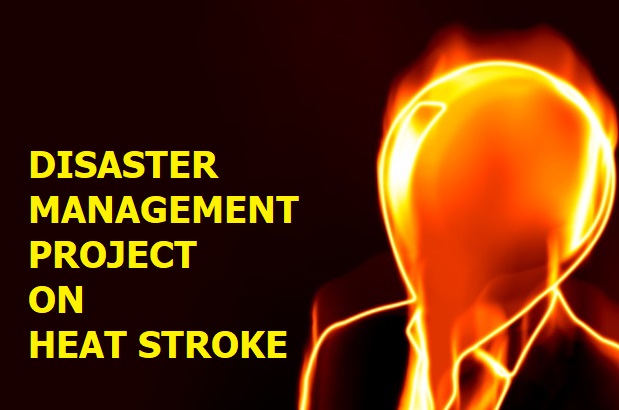Disaster Management Project On HEAT STROKE In Central India
Disaster Management Project On HEAT STROKE In Central India

PROJECT ON HEAT STROKE IN INDIA
1. DEFINE HEAT STROKE
Start your project by defining Heat stroke.
Heat stroke is a type of heat injury that occurs when the body is unable to regulate its core temperature.
It is a medical emergency and can be life-threatening if not treated promptly.
Symptoms of heat stroke can include
- high body temperature (often 104°F or higher),
- sweating that stops or skin that is hot and dry to the touch,
- rapid pulse,
- headache,
- confusion,
- dizziness,
- nausea, and
- loss of consciousness.
Moreover, the condition is most commonly caused by prolonged exposure to high temperatures and inadequate fluid intake.
But other factors such as certain medications, illnesses, and excessive physical activity can also increase the risk of heat stroke.
Therefore, it is important to seek immediate medical attention.
Finally, If you suspect someone has a heat stroke, delaying treatment can lead to serious complications.
Disaster Management Project On HEAT STROKE In Central India

PROJECT ON HEAT STROKE
2. WHY HEAT STROKE IN CENTRAL INDIA?
Heat stroke is a concern in central India for several reasons, including:
High temperatures
Central India experiences high temperatures and high humidity during the summer months, which can increase the risk of heat stroke.
Lack of awareness
There may be a lack of awareness about the signs and symptoms of heat stroke and how to prevent it, which can increase the risk of the
condition.
Limited access to air conditioning
Air conditioning is not widely available in many areas of central India, making it difficult for people to stay cool and avoid heat stroke.
Physical labor:
Many people in central India work in physically demanding jobs.
For example, farming or construction work.
This further can increase the risk of heat stroke due to increased body temperature and fluid loss.
Limited access to clean water
Access to clean drinking water may be limited in some areas of central India, which can increase the risk of dehydration and heat stroke.
It is important for individuals in central India to take steps to prevent heat stroke.
Therefore following precautionary measures must be taken such as,
Firstly, drinking plenty of water
Secondly, wear light and loose-fitting clothes.
Thirdly, avoid outdoor activities during the hottest parts of the day, and
Lastly, seek shade or air-conditioning when possible.
Note:
Moreover, If you suspect someone has a heat stroke, it is important to seek immediate medical attention.
Disaster Management Project On HEAT STROKE In Central India
3. DESIGNING A COVER PAGE

HEAT STROKE PROJECT
The cover page of your project gives the first impression.
Therefore, design a very creative cover page.
Do not forget to mention the title of your project, your name, class, section, roll no, etc.
Here’s a sample design for a cover page on heat stroke:
Title:
“Heat Stroke: Understanding the Risks and Prevention”
Subtitle:
“Stay Safe During the Hot Summer Months”
Image:
A large, eye-catching image of a person sweating profusely, with a red background to represent heat.
Colors:
The main colors used could be red and yellow, to represent heat and caution, respectively.
However, other colors could include green to represent health and wellness, and blue to represent calmness and hydration.
Layout:
The title and subtitle could be placed in the center of the page, with the image to the left or right.
However, the title and subtitle could be in large, bold font to catch the reader’s attention.
Disaster Management Project On HEAT STROKE In Central India
4. WRITING INDEX
Firstly, think of the topics you want to include in your project.
Secondly, note it down in a rough copy.
Here’s a sample index for a project on heat stroke:
- Introduction
- Causes of Heat StrokeIII.
- Symptoms of Heat Stroke
- High body temperature
- Sweating that stops or skin that is hot and dry
- Rapid pulse
- Headache, confusion, dizziness, nausea
- Loss of consciousness
- Prevention of Heat Stroke
- Treatment of Heat Stroke
- Conclusion
Note:
Depending on the length and scope of the project, additional sections or sub-sections may be added to the index.
Disaster Management Project On HEAT STROKE In Central India
5. INTRODUCTION TO PROJECT ON HEAT STROKE IN CENTRAL INDIA
Heat stroke is a serious medical condition that can have devastating consequences.
Particularly in areas where high temperatures are common.
As you know, Central India is one such region that experiences hot and humid summers.
This makes it particularly vulnerable to heat stroke.
Heat stroke occurs when the body is unable to regulate its core temperature and begins to overheat.
This can result from prolonged exposure to high temperatures, inadequate fluid intake, certain medications, illnesses, and excessive physical activity.
SYMPTOMS OF HEAT STROKE
The symptoms of heat stroke can range from mild to severe and can include high body temperature, sweating that stops, rapid pulse,
headache, confusion, dizziness, nausea, and loss of consciousness.
If left untreated, heat stroke can lead to serious complications and permanent damage to the brain and other organs.
Given the high risk of heat stroke in central India, it is important to increase awareness of the condition and take steps to prevent it.
This can include staying hydrated, wearing light and loose-fitting clothing, avoiding outdoor activities during the hottest parts of the day, and
seeking shade or air-conditioning.
Note:
By taking these simple steps and seeking prompt medical attention if heat stroke is suspected, we can help to protect the health and
the well-being of individuals in central India and beyond.
Disaster Management Project On HEAT STROKE In Central India
6. PRECAUTIONS TO BE TAKEN BEFORE A HEAT STROKE
Taking precautions to prevent heat stroke is important, especially during hot and humid weather conditions.
Here are some steps that you can take to reduce your risk of heat stroke:
Stay hydrated
Drink plenty of water, especially before and during physical activity.
Avoid beverages that contain alcohol or caffeine, as they can increase fluid loss.
Wear appropriate clothing
Wear lightweight, light-colored, and loose-fitting clothing. Wide-brimmed hats and sunglasses can also help to protect you from the sun.
Avoid outdoor activities during the hottest parts of the day
Try to avoid outdoor activities during the peak hours of the day when temperatures are the highest, typically between 10 a.m. and 4 p.m.
Seek shade or air-conditioning
When possible, seek shade or spend time in air-conditioned buildings.
If you don’t have access to air conditioning, take advantage of cooling centers or other public facilities.
Limit physical activity
Avoid overexertion and limit physical activity, especially during hot weather. Take frequent breaks, and pace yourself.
Monitor your symptoms
Be aware of the symptoms of heat stroke, and if you experience any of them, seek immediate medical attention.
Take precautions for children and the elderly:
Children and the elderly are more susceptible to heat stroke, so it is important to take extra precautions to protect them.
Note:
By following these precautions and taking other steps to prevent heat stroke, you can help to reduce your risk of this serious condition and
stay healthy during hot weather
Disaster Management Project On HEAT STROKE In Central India
7. WORK TO BE DONE DURING A HEAT STROKE
If you or someone you know is experiencing a heat stroke, it is important to take immediate action to cool the body and seek medical
attention.
Here are some steps you can take:
Call for emergency medical assistance:
If you suspect someone has a heat stroke, call for emergency medical assistance immediately.
Heat stroke is a serious medical emergency and prompt treatment is essential.
Move the person to a cooler place:
Remove the person from the heat and move them to a cooler place, such as an air-conditioned building or a shaded area.
Remove excessive clothing:
Remove excessive clothing, such as heavy jackets, hats, or shoes, to allow for heat dissipation.
Cool the body:
Use cool compresses, such as wet towels or cloths, to cool the person’s skin. You can also place the person in a cool bath or spray them with
cool water.
Give fluids:
Encourage the person to drink water or an electrolyte-rich beverage to help replace fluids lost through sweating.
Monitor vital signs:
Monitor the person’s vital signs, such as pulse and breathing, until emergency medical assistance arrives.
Avoid heat exposure:
Avoid exposing the person to heat again until they have fully recovered.
Note:
It is important to seek medical attention as soon as possible if you suspect someone has a heat stroke.
Prompt treatment can prevent serious complications and permanent damage to the brain and other organs
Disaster Management Project On HEAT STROKE In Central India
8. PRECAUTIONS TO BE TAKEN AFTER A HEAT STROKE
After a heat stroke, it is important to take steps to prevent further heat exposure and to promote recovery.
To begin with, Here are some precautions that you can take:
Rest
Firstly, rest is important to allow the body to recover from the strain of heat stroke.
Avoid heat exposure
Secondly, avoid exposure to high temperatures and limit outdoor activities until you have fully recovered.
Stay hydrated
Thirdly, drink plenty of water to help replenish fluids lost through sweating and to prevent dehydration.
Avoid alcohol and caffeine
Fourthly, avoid alcohol and caffeine, as they can increase fluid loss and make it more difficult to stay hydrated.
Take medications as prescribed
Next, If you have been prescribed medication to treat heat stroke or its symptoms, take the medication as directed.
Follow up with your doctor
Furthermore, do not forget to follow up with your doctor to ensure that you have fully recovered and to discuss any ongoing medical needs.
Wear appropriate clothing
Always wear lightweight, light-colored, and loose-fitting clothing to help regulate body temperature.
Be aware of the warning signs
Finally, be aware of the warning signs of heat stroke.
If you experience any of these symptoms, seek immediate medical attention.
Note:
By following these precautions and taking other steps to prevent heat exposure, you can help to protect your health and promote recovery
after a heat stroke
Disaster Management Project On HEAT STROKE In Central India
9. HOME REMEDIES FOR HEAT STROKE
While medical attention is essential for heat stroke, there are some home remedies that can help to provide relief and support the recovery
process:
Hydration:
Firstly, Drinking plenty of water is essential to replenish fluids lost through sweating.
You can also drink electrolyte-rich beverages, such as sports drinks, to help replace lost electrolytes.
Cool compresses:
Secondly, placing cool compresses, such as wet towels or cloths, on the skin can help to lower body temperature and provide relief.
Cool bath:
Thirdly, taking a cool bath or shower can also help to lower body temperature and provide relief.
Rest:
Fourthly, resting in a cool, shaded place can help to reduce stress on the body and promote recovery.
Light clothing:
Finally, wearing lightweight, light-colored, and loose-fitting clothing can help to regulate body temperature.
Note:
It is important to remember that these home remedies are not a substitute for medical treatment.
If you suspect that you or someone you know has a heat stroke, seek medical attention immediately.
Disaster Management Project On HEAT STROKE In Central India
10. CONCLUSION
Do not forget to mention the conclusion in your disaster management project.
In conclusion, generally, you have to summarize your disaster management project on Heat Stroke.
heat stroke is a serious and potentially life-threatening condition that is especially prevalent in regions with high temperatures
and low humidity, such as in Central India.
The symptoms of heat stroke can develop quickly and can include high body temperature, sweating that stops, rapid pulse, headache,
confusion, dizziness, nausea, and loss of consciousness.
However, to prevent heat stroke, it is important to take steps to limit exposure to heat, stay hydrated, wear appropriate clothing, and be
aware of the warning signs of heat stroke.
If you suspect that you or someone you know has a heat stroke, seek medical attention immediately.
In Central India, where temperatures can reach extremely high levels during the summer months, it is essential to take precautions to protect
yourself and others from heat stroke.
By taking steps to stay cool, hydrated, and aware of the warning signs of heat stroke, you can help to prevent heat-related illness and
promote health and well-being during the hot months.
Finally, your disaster management project on Heat Stroke is now ready to submit.





0 Comments